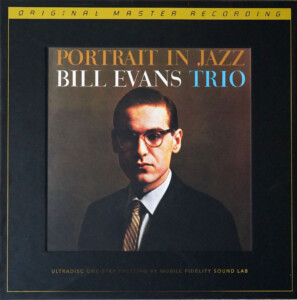Evans’ Portrait In Jazz is an equally exceptional performance by the same trio (Evans with LaFaro and Paul Motian) and if I were limited to three essential Evans’ recordings on the Riverside label, this would make the cut along with SAVV and Waltz For Debby. Recorded on December 22, 1959, at Reeves Sound Studios, Portrait In Jazz might lack the sonic magic of the other two albums, but when it comes to performance, it stands toe to toe with the Vanguard sessions.
 Where does the scarcity of new high quality vinyl re-issues leave someone who wants to buy a good sounding vinyl copy of SAVV, Waltz for Debby or Portrait In Jazz? The only new vinyl that appears to be available is from companies like Wax Time, which are probably dubs from CD. All the high-quality digital media (gold CD, SACD & HQCD versions) sold out long ago. That leaves two choices — there’s nothing available new that is worth having, other than the OJC CDs that are widely available. Acquiring original pressings of Riverside titles means buying multiple copies until you get one that is almost quiet (the best you can hope for) as well as well centered, as there was little if any quality control at the pressing plants used by Riverside at that time. Riverside re-issues, like the teal label “Orpheum Productions” pressings might be a little better from a pressing quality standpoint, but they have inferior sound to the original.
Where does the scarcity of new high quality vinyl re-issues leave someone who wants to buy a good sounding vinyl copy of SAVV, Waltz for Debby or Portrait In Jazz? The only new vinyl that appears to be available is from companies like Wax Time, which are probably dubs from CD. All the high-quality digital media (gold CD, SACD & HQCD versions) sold out long ago. That leaves two choices — there’s nothing available new that is worth having, other than the OJC CDs that are widely available. Acquiring original pressings of Riverside titles means buying multiple copies until you get one that is almost quiet (the best you can hope for) as well as well centered, as there was little if any quality control at the pressing plants used by Riverside at that time. Riverside re-issues, like the teal label “Orpheum Productions” pressings might be a little better from a pressing quality standpoint, but they have inferior sound to the original.
The Analogue Productions re-issues are all worth having, and sound better than any original, but are expensive on the used market. Portrait In Jazz, which lacks the cachet of the Village Vanguard sessions, because of the inferior sound, is available on the used market in the Analogue Productions series and as a Mobile Fidelity One Step pressing. Despite the current internet dust up about Mobile Fidelity’s use of a digital step in the production chain, this One Step has better sound than either the original or the Analogue Production re-issues.
At the end of the day, patience is a virtue when it comes to acquiring high quality Riverside pressings. The box set will become available soon, and if you are ready to shell out enough to purchase the massive box set, that is the way to go. On the other hand, if you have patience, remember that the Village Vanguard session titles are and have always been in extremely high demand. It is difficult to believe that individual titles will not eventually be reissued by Analogue Productions.
The Switch To Verve…
Whatever your game plan is for picking up the Riverside titles, there are other avenues to explore in the interim. Bill Evans continued to produce great music after he switched from Riverside to Verve in 1963. He was at the height of his artistic powers at that time and these recordings feature some of the era’s top drummers and bassists.
What also sets these Verve recordings apart from the Riverside years is the sound quality of the recordings. Riverside, which produced some of the greatest jazz artists from 1954 through 1963, farmed out the recording work to several independent studios. That often produced very good, if not stellar sounding recordings. The Verve releases were recorded in a variety of venues, but in general those venues had superior acoustics and were recorded by some of the best recording engineers of the time, including Rudy Van Gelder and Bob Simpson.

